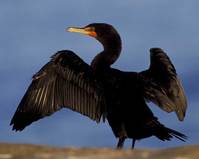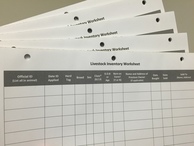|
Having trouble viewing this email? View it as a Web page.
|
|
|
|
|
|
Be on alert for West Nile Virus
 West Nile Virus is regularly found in the United States, and birds serve as the primary host of the disease. Infected mosquitoes can transmit the virus from birds and then carry it to horses or people. The virus can cause encephalitis, an inflammation of the brain and spinal cord. Infected horses may or may not show neurological symptoms and many recover completely, especially with annual vaccinations.
Vaccines for horses are widely available and have been proven to be effective in preventing infection. Steps can also be taken to reduce disease risk by reducing mosquitoes.
- Change water in drinking troughs every week.
- Mow long grass.
- Drain stagnant water puddles.
- Remove items mosquitoes use for breeding grounds, like old tires and tin cans.
- Place and maintain screens over windows and stable doors.
- Horses and people can also be protected from mosquitoes by using repellents.
Read more
|
Disease Alert: Newcastle Disease in cormorants
 The USGS National Wildlife Health Center confirmed virulent Newcastle Disease virus (vNDV) in Minnesota double-crested cormorants. Three counties were identified with positive cases; Mille Lacs, Rice and Pope. Several other counties in Minnesota have pending test results.
The virus is
excreted from the respiratory and intestinal tracts. This means it can be spread
from wild bird contact or contaminated equipment, feed or people tracking it
into a barn.
Biosecurity practices are encouraged on poultry farms. The same measures used for high-path avian influenza will also help prevent vNDV. Use a line of separation in barns, limit visitors, wear dedicated clothing and footwear, and prevent wild bird contact by inspecting and maintaining the building.
Signs of infection include:
- Unexplained increase in death loss (could be significant).
- Marked depression of birds with respiratory signs, marked cough, and nasal
and eye discharge.
- Wattles and combs may turn dark and there may be swollen
heads.
- A greenish diarrhea may be present.
If producers see an
unexplained increase in death loss along with depression they should call
either the MPTL at 320-231-5170 or Dr. Greg Suskovic at 651-238-2503.
Please note, vNDV has only been seen in wildlife, specifically in
cormorants. Zero domestic poultry flocks have been identified with vNDV in the U.S. at this time.
|
Poultry testing lab closing during relocation
 Friday, August 19 - The last day for
testing samples at the temporary Minnesota Poultry Testing Laboratory (MPTL), 1109 High Avenue.
Monday, August 22 - The MPTL will be closed and will not accept
samples during moving to the renovated building.
Tuesday, August 23 - The MPTL will be closed and will not accept samples during moving to the renovated building.
Wednesday, August 24 - The MPTL will begin to accept samples at the 622 Business Hwy 71 NE location. However, it will NOT be
running tests.
Monday, August 29 - Full operations are expected to resume (diagnostic serology, bacteriology, NPIP testing, Board
programs). PCR
testing and poultry necropsies will not be available until technicians are trained and a diagnostician is hired.
Please save the date for a MPTL open house event on Thursday, September 22.
Many people will still need testing services while the MPTL is closed. Below is a list of suggested replacement labs for
poultry testing procedures. All testing performed at these laboratories, during this time period, will be billable to the client unless prior approval has been provided by the
Board.
University of Minnesota Veterinary Diagnostic
Laboratory, St. Paul, MN; 800-605-8787; vdl@umn.edu
South Dakota State University Diagnostic Laboratory, Brookings, SD; 605-688-5171; sdsu.adrdl@sdstate.edu
Iowa State University Veterinary Diagnostic Laboratory, Ames, IA; 515-294-1950; isuvdl@iastate.edu
|
Keep official identification records
 Accredited veterinarians are required to keep records of when they distribute official identification eartags. Records must also be kept when an accredited veterinarian or livestock producer applies official identification eartags. The records of this information must be held for five (5) years.
Accredited veterinarians must record the name, date and property address when the tags are distributed to producers.
Application records must include where and when the tag was applied, the eartag number, any other official tags already in the animal, and individual animal information (species, sex, age, and animal type).
See our official ID page
|
|
|
|
©2016 Minnesota Board of Animal Health | 625 Robert St N | St Paul | 55155 | www.bah.state.mn.us
|
|
|